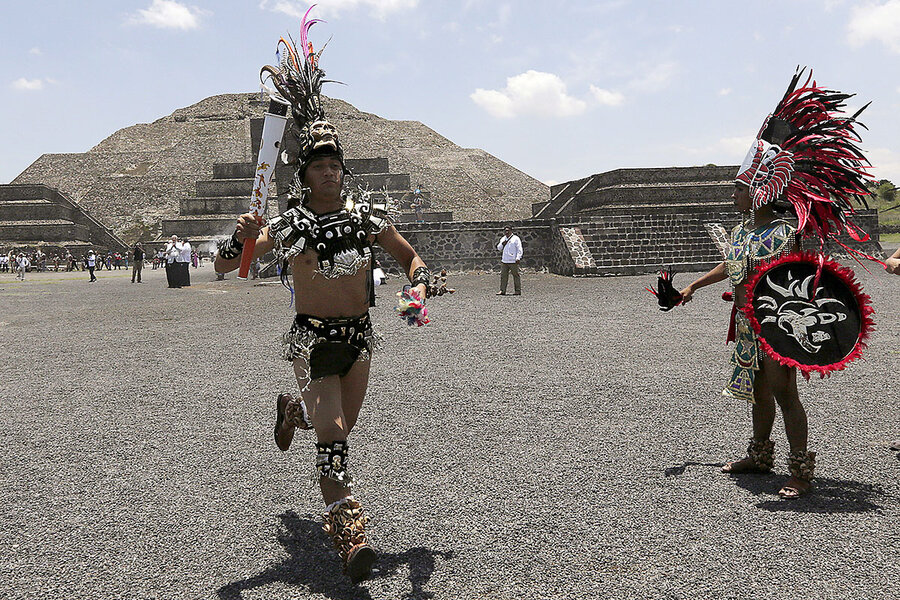AP test debate: How much world history should high-schoolers know?
Loading...
When the College Board announced in May that it was changing the breadth of the AP World History test, it prompted a backlash from teachers and students. The organization said some educators had trouble covering 10,000 years of history in one exam. But opponents argue that the new test – which starts with AD 1450 – eliminates valuable opportunities to study non-Western cultures before European imperialism. The stakes are highest, they say, for students of color, whose own cultural histories hang in the balance. Tanariea Deloney, a sophomore who identifies as black and Native American, says she had rarely seen herself represented in a positive light in history classes until she took AP World History. The course highlights powerful and wealthy kingdoms in West Africa, like the Mali Empire, and the technological advancements of indigenous communities in the Americas. “[It is] really important to me that I am knowledgeable about my culture ... instead of just coming into class and starting with, ‘Oh, so your culture got wiped out by these people’ or ‘Your people were slaves,’ ” she says.
Why We Wrote This
What – and who – is valuable? Many students find the answers in their classes. If a popular national test excludes history prior to European colonization, some critics are concerned about the message that sends.
At its peak in the 13th century, the Mongol Empire covered more than 9 million square miles, ranking as the largest contiguous land empire ever recorded. But despite the Mongols’ historical dominance, their future – at least in high school history classes – is notably less certain.
In late May, the College Board’s Advanced Placement (AP) program, which develops tests that offer college credit to high-performing high schoolers, announced changes to its World History exam. Advanced students typically spend their sophomore year preparing for the test in a class that covers 10,000 years of human history. But driven by teacher concerns over this tremendous breadth, the College Board has removed any content prior to the year AD 1450, starting in the 2019-2020 school year.
Since then, a chorus of protests from students and teachers has echoed across the country. One petition started by a ninth-grade AP World History student to reverse the change has amassed more than 10,000 signatures online. The new exam, opponents argue, eliminates valuable opportunities to study non-Western cultures outside of the context of European influence. The stakes are highest, they say, for students of color – whose own cultural histories hang in the balance.
Why We Wrote This
What – and who – is valuable? Many students find the answers in their classes. If a popular national test excludes history prior to European colonization, some critics are concerned about the message that sends.
“What gets lost if you start [studying history] at the European Renaissance is you miss the whole point that these African and Asian cultures develop a lot of that science and math that then influences Europe. As a black or brown student, you don’t learn that it was your cultures that figured that out,” says Amanda DoAmaral, a former AP World History teacher and founder of Fiveable, an online AP prep startup.
“Part of what we [try] to do is just really reflect our students in what we’re teaching. And I think that’s true for all students... You still have to be there in the curriculum somewhere,” she says.
An unwieldy topic
The AP World History Development Committee has consistently seen disappointingly low and uneven test results on the national level, says Richard Warner, a history professor at Wabash College in Crawfordsville, Ind., and a committee member.
“From the College Board’s perspective, the unwieldiness of 10,000 years of history argued for making it a modern history course so that they could handle it a little bit better,” Dr. Warner says.
In a 2017 College Board survey of 1,243 AP World History teachers, 79 percent stated that “there is too much required content to cover in one academic year.”
But not all AP World History teachers agree with that assessment. And many see the wide scope of the course as an essential part of building frameworks of understanding across time periods and world regions, says Laura Mitchell, a history professor at the University of California, Irvine and a former AP World History test-development committee chair.
A week ago, Dr. Mitchell released a letter signed by all former chief readers and test development committee chairs that advocates against the College Board’s decision.
And despite the concern over breadth, 88 percent of 888 AP World History instructors in a teacher-led survey conducted after news of the exam changes broke disagreed with the new test format. Of that group, 53 percent opted for a new design that would include Period 3, a unit within the course that covers history from AD 600 to AD 1450.
The College Board has also developed a pre-AP curriculum that would include earlier world history. A statement provided to the Monitor by the College Board says the organization believes that the Period 3 content is “so important that teachers and students must be given the time to study the topics ... with great care, including reading and analyzing the primary and secondary sources and writing essays that use evidence accurately and effectively.”
But because this new course wouldn’t result in college credit, there’s a disincentive for advanced students to take it, says Dylan Black, the student behind the online petition. And although the course itself would be free for schools to offer, some would be subject to fees of up to $6500 if they chose to provide professional development and unit exams from the College Board.
Impact on students of color
Tanariea Deloney is a sophomore at Skyview High School in Vancouver, Wash. As a black and Native American student, she says she has rarely seen herself represented in a positive light in history classes. But with AP World History, that changed dramatically. The course highlights powerful and wealthy kingdoms in West Africa, like the Mali Empire, and the technological advancements of indigenous communities in the Americas.
“[It is] really important to me that I am knowledgeable about my culture... instead of just coming into class and starting with ‘Oh, so your culture got wiped out by these people,’ or ‘Your people were slaves,’ ” she says.
Others in her class recognize that the benefits of the course apply to everyone. “It's very important for people of color to know where they came from and what their ancestors did and the accomplishments they made, but it's also very important to [white people] as well,” says Amy Cisneros, another Skyview AP World History student. “It's very important to know about other cultures to bring diversity to their opinions. It helps to open up people’s eyes....”
For most public school students in the US, says Mitchell, World History is the sole opportunity to explore regions outside of Europe before colonization.
That lack of representation came to the fore in a video distributed by Ms. DoAmaral at this year’s AP World History Open Forum – where the changes were announced. On screen, she addresses Trevor Packer, the head of the Advanced Placement program, saying “Period 3 is so important to… showing our black and brown and our Native students that their histories matter, their histories don’t start at slavery, their histories don’t start at colonization.”
Mr. Packer did not respond to the Monitor’s requests for comment.
At Tanariea’s school, AP World History students regularly create banners at the end of the year to celebrate finishing the challenging course. This year, the banners abandoned typical congratulatory praise to embrace messages like “#SavePeriod3” and “#NotMyCollegeBoard.” The signs were dotted with world flags and some featured symbols from early world history, including Mesopotamian Ziggurats and Egyptian pyramids, and were distributed via a Twitter account called “@SaveAPWorld1,” started by a classmate.
Evaluating the responses
For now, the College Board is still considering how to respond to the outpouring of responses it has received, says Warner. Packer tweeted statements two weeks ago that suggested further changes to the test may be released in July. The World History Development Committee has been meeting to explore revisions to the exam, including pushing the start date back to AD 1200 – which would include the rise of the Mongols.
But even as he works to respond to voices of concern and outrage, Warner values the investment students and teachers have in the course.
“I take it in a very positive way… They're passionate about it… [H]opefully they don't stop with this one initiative in terms of trying to make some kind of arrangement of peace with the community here. Hopefully we will be able to find other ways to bring people together on it,” he says.








